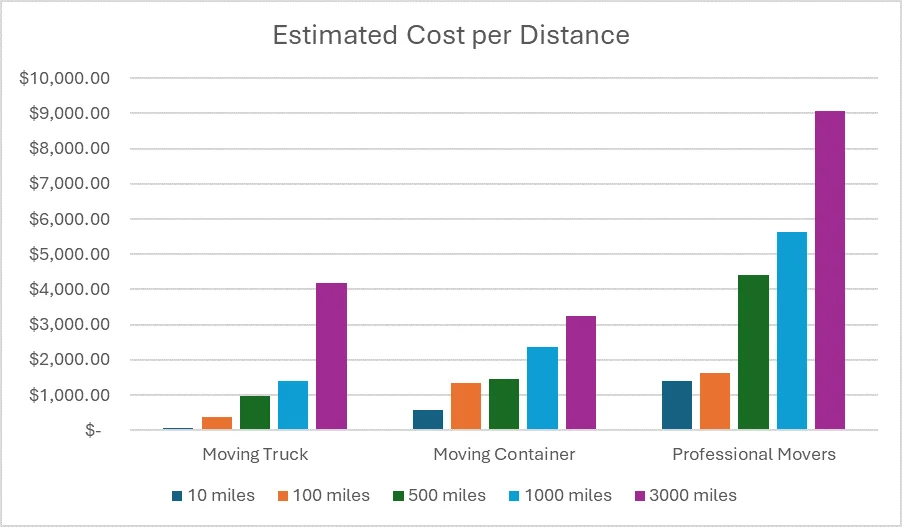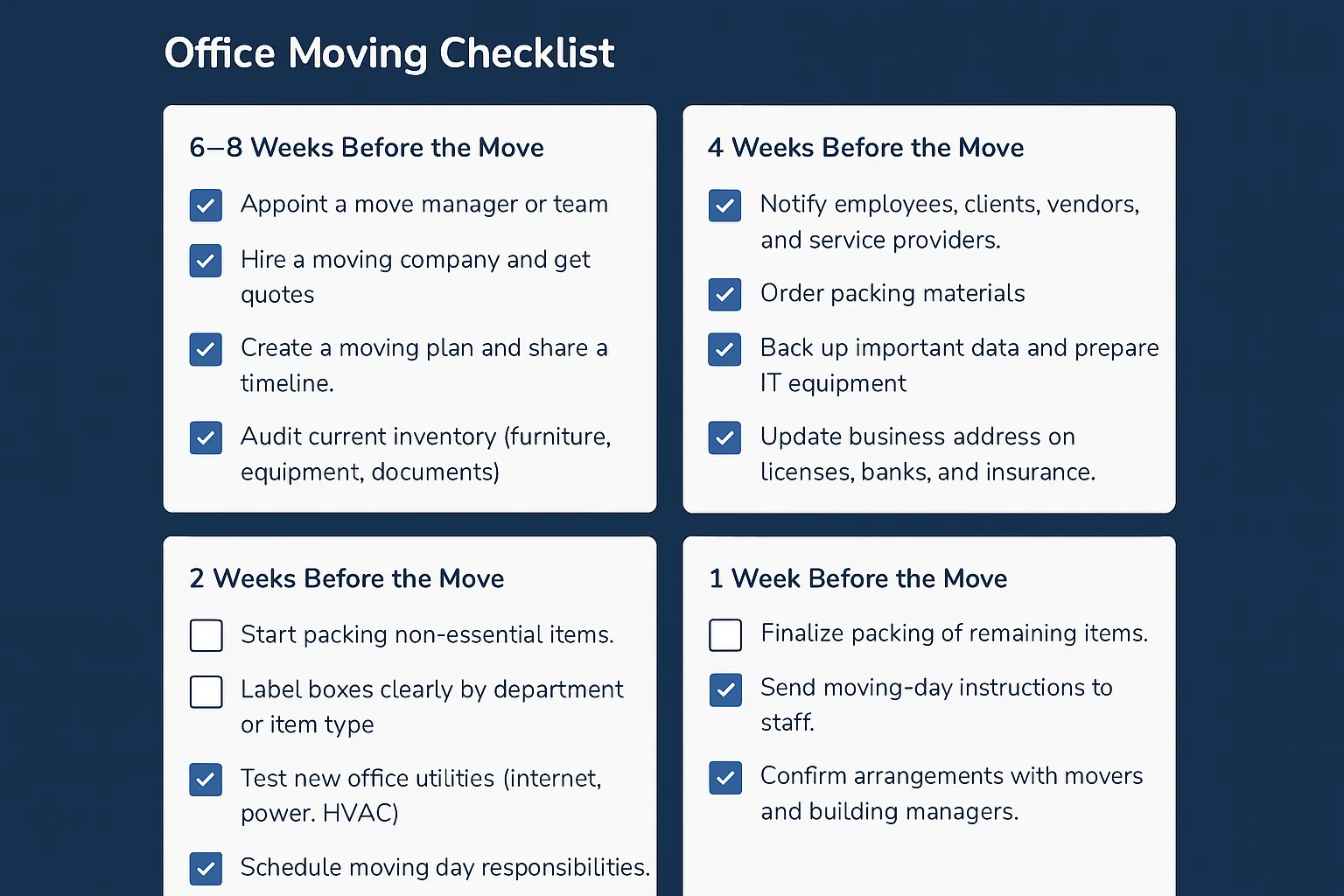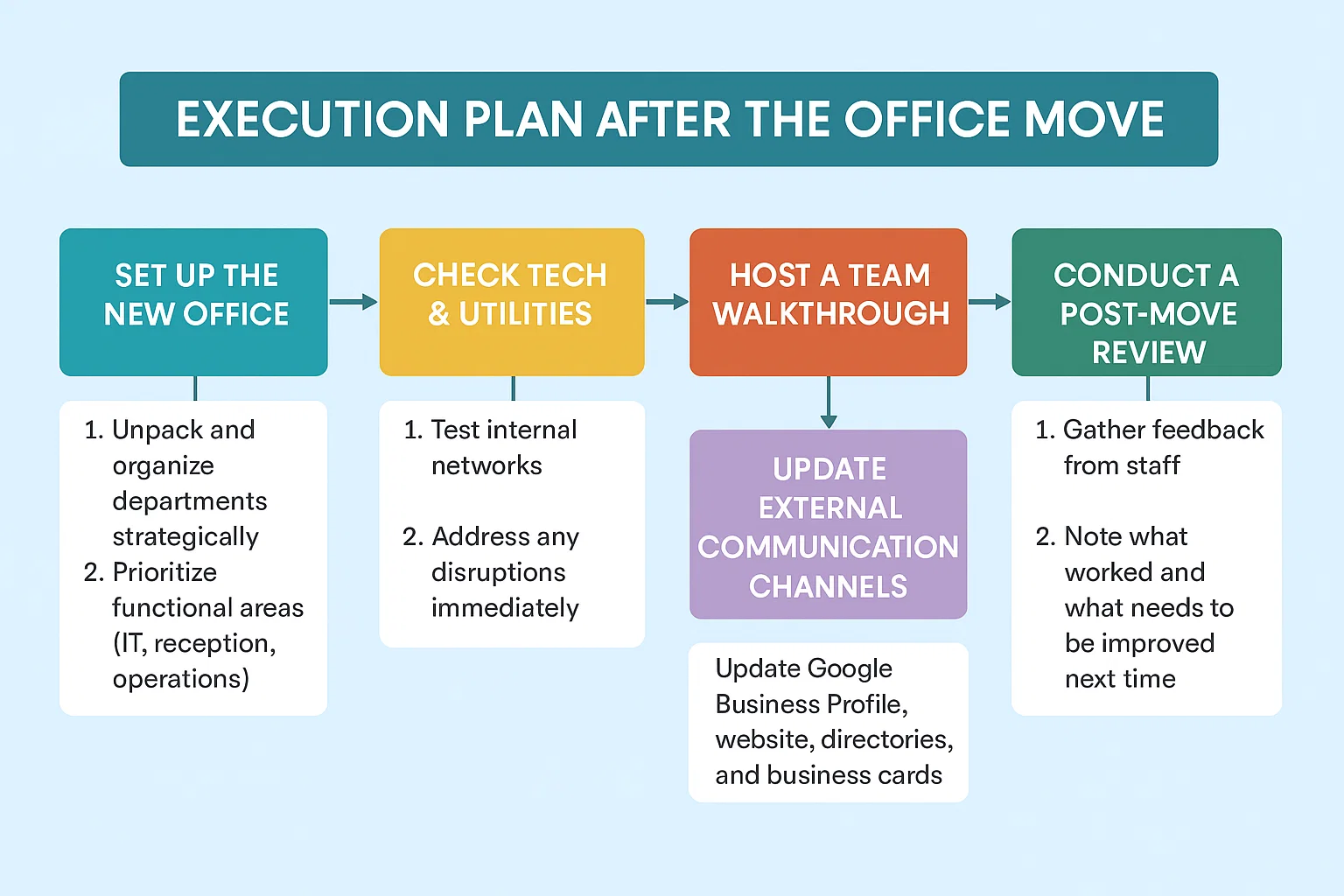
Save Time and Money With This Office Move Checklist
Offices move for more space, less rent, or a tighter fit. Relocating, when handled well, boosts morale and productivity, while inadequate support can lead to significant declines in performance.
The key is a well-planned office moving checklist. It’s a simple tool that helps the success of a smooth relocation and keeps you focused. On top of that, it reduces downtime and avoids extra costs.
Things to Consider Before Moving Office
1. Move Timing and Strategic Scheduling
Timing is crucial when moving offices. A smart schedule can make even a messy move proceed more smoothly. Plan out at least six months in your office move checklist to make packing and settling hassle-free.
2. Efficient Packing and Smart Labeling Systems
Packing is easily one of the most draining parts of an office move. Make it easier by setting clear packing rules early. Assign someone from each team to oversee their department’s things.
Be sure to label everything clearly since it helps movers and staff quickly get things where they need to be. It also protects computers and other equipment from getting lost or damaged.
3. IT Infrastructure and Technical Transition
Get internet, Wi-Fi, and phones set up before moving day. Don’t forget insurance—one mishap can cost a lot. Invest in hybrid solutions like desk booking tools that sync calendars and track real-time usage.
4. Workspace Planning and New Office Layout
Creating heatmaps contributes to planning zones—for focus, teamwork, and casual breaks. Including your team in the planning process helps shape a better space.
Workplace technology like desk reservation software with 3D floor mapping can also give you a detailed visual of your office space.
5. Internal Communication and Team Coordination
The next step is to set up a small team. Assign defined roles and hand them the office relocation checklist to stay on track.
Quick emails or Slack messages can help with seating and tech setup. Asking for daily updates can also help you stay on track by finding problems early.
6. Financial Planning and Budget Management
The budget section of your office move checklist must include allocations for your space setup and services. On top of that, you should add a buffer for any hidden expenses. Request quotes from several companies to know their coverage.
Remember that the estimated cost of hiring a moving company can be higher than a DIY move. We’ve included a graph to help you decide:
7. Security Measures and Safety Compliance
Handle IT equipment carefully and use cybersecurity tools to protect your data in transit. Coordinate with your property manager about alarm systems or outside office security help. Once settled, test everything.
8. Unpacking Strategy and Operational Setup
Include color and number assignments in your office moving checklist to help your team stay organized. Share the office layout with staff and movers, then assign people to set up furniture and key gear first.
9. System Testing and Technical Troubleshooting
Check for hardware or software issues before anything gets packed. A clear record helps with insurance in case of damage.
Office Moving Checklist
6–8 Weeks Before the Office Move
1. Appoint a Move Manager or Team
Appoint a move manager who can go back and forth between vendors while keeping you updated. On top of that, be sure to give each team member a clear role to keep the process as smooth as possible.
2. Hire a Moving Company and Get quotes
When collecting quotes, look at how they are calculated. Some movers charge hidden fees, like extra costs for bulky items or weekend moves. If a deal seems too good to be true, it probably is.
3. Create a Moving Plan and Share a Timeline
Map out your move, add them to your checklist for office relocation, and share it. Everyone should know when and what is happening to avoid last-minute surprises.
4. Audit Current Inventory (furniture, equipment, documents)
Audit everything and list it all down. This quick audit helps you decide what stays, what goes, and what can be donated.
4 Weeks Before the Office Move
1. Notify Employees, Clients, Vendors, and Service Providers
Let the rest of the team know the move details early so they can plan their commutes. As part of your office move checklist, don’t forget your clients, vendors, and service providers—send them your new address and contact info.
2. Order Packing Materials
Use your inventory list to determine how much packing material you need. Fork some cash over reusable bins; they are much more durable and reusable.
3. Back Up Important Data and Prepare IT Equipment
Use cloud storage to keep files safe and accessible—no matter where you are. It’s a smart way to protect your info and avoid data loss.
4. Update Business Address on Licenses, Banks, and Insurance
Don’t forget to update your business address. Let your bank, insurance, partners, and licensing bodies know where to reach you.
2 Weeks Before the Office Move
1. Start Packing Non-essential Items
When packing, go heavy on the bottom and light on top. It keeps boxes safe and balanced. Begin with stuff you won’t need immediately, and disassemble the gear and furniture.
2. Label Boxes Clearly by Department or Item Type
Color and number labels make moving way easier. Give each department a color, then number the boxes within that group. Clearly label fragile items. It’s simple—anyone can quickly tell where a box belongs.
3. Test New Office Utilities (internet, power, HVAC)
Double-check that your new office is fully powered and connected two weeks in advance. Test the internet, electricity, and HVAC systems to avoid any downtime.
4. Schedule Moving Day Responsibilities
Before moving day, assign duties like supervising movers or tracking department to avoid confusion, share responsibilities early, and ensure both locations have the exact timetable and access.
1 Week Before the Office Move
1. Finalize Packing of Remaining Items
Start packing the essentials—and pack them with care. Set aside anything that should be recycled, donated, or tossed out.
2. Send Moving-day Instructions to Staff
Always review the business moving checklist and remind your team what tasks they’re responsible for. Also, ensure they’re updated on accessing the new office—keys, codes, or badges should be good to go.
3. Confirm Arrangements with Movers and Building Managers
Examine everything with your movers and building managers. Double-check the schedule, access points, parking permits, and elevator bookings. Clear plans now mean fewer surprises on moving day.
Office Moving Day
The die is cast. The trucks are ready, everything is packed, and there’s no turning back.
1. Assign Team Leaders for Supervision
Once you’re finally moving office locations, assign team leads to oversee specific areas. They’ll work with the movers, check the labels, and handle any problems. Clear leadership keeps the move on track and organized.
2. Conduct a Final Walkthrough of the Old Space
Scan the vacated office once more. Double-check each shelf, drawer, and corner against the inventory sheet. Leave the space in good shape.
3. Ensure Safe Transportation of IT Equipment
Shut down all workstations, servers, and other devices. Wrap coil cables neatly and put them in moving boxes with anti-static foam. Put a label on each box that says what it is and where it’s going.
4. Document Any Damages for Claims
Take pictures and write down any damage. You might need it to make an insurance claim.
Simplify Office Moves with DeskFlex
Plan smarter, cut downtime, and keep teams productive with our flexible workspace management solutions.
Execution Plan After the Office Move
Set Up the New Office
1. Unpack and Organize Departments Strategically
Arrange furniture and equipment for each team to provide designated spaces for their belongings. Keep frequently used items near workstations for easy access. Use a floor plan to mark each department’s zones to avoid confusion.
2. Prioritize Functional Areas (IT, reception, operations)
Get computers, phones, and networks online to connect with everyone, starting with IT. Look after the mailroom and supply areas. Next, get the reception area ready to greet visitors.
Check Tech & Utilities
1. Test Internal Networks
Check devices and internal networks inside the building. Start with the internet and Wi-Fi to ensure a stable connection. Next, check the phones and work down the printers and scanners.
2. Address Any Disruptions Immediately
If your team finds problems within the first hour, the IT engineer should work closely with the lead mover. Both should report to a move coordinator to keep everyone updated.
Host a Team Walkthrough
1. Walk Your Team Through the New Office
Show the most important areas of the workplace to your staff. This way, everyone knows where to work, eat, and exit in an emergency. If anyone missed it, share a map or a short video.
2. Create a Positive Atmosphere to Boost Morale
You made it! Throw an office warming party or treat the team to coffee and snacks. It doesn’t have to be big – just something to say thanks. If you have remote staff, send them pizza – small gestures go a long way.
Update External Communication Channels
Update Google Business Profile, Website, Directories, and Business Cards
Relocate your address on Google Business Profile first to foster customer loyalty. Revise your website, social media pages, directories, and emails. You should also print fresh business cards that reflect your new address.
Conduct a Post-Move Review
1. Gather Feedback from Staff
The final step in your office move checklist is to gather feedback using a quick survey.
2. Note What Worked and What Needs to be Improved Next Time
Document each insight. Review the entire project. Note what worked and identify areas needing improvement to make the next experience smoother!
Tips to Save Time and Money During the Office Move
1. Declutter Before Packing to Reduce the Load
Decluttering saves time, money, and stress. Scan important papers and take photos of your current setup to see what’s worth bringing.
2. Use Reusable Bins Instead of Boxes
Reusable bins are a smart upgrade for any office move. They’re sturdier than cardboard, so your items stay protected. Plus, they can be reused, saving money and reducing waste. It’s a cleaner, greener way to pack.
3. Move During Off-peak Business Days
Plot a quiet day and write it in the moving office checklist. Midweek or off-hours usually mean less foot traffic and fewer interruptions. It’s also easier to book movers when demand is low.
4. Bundle IT Setup with Your Moving Service
Bundling your IT setup with your moving provider can save you time and effort. Consider office automation tools to make scheduling, approvals, and talking to your team easier.
5. Reuse or Sell Old Furniture
Selling or donating items helps you unload unused inventory and save on some of the moving costs.
Conclusion
Moving an office can feel stressful but the right checklist makes it easier. Plan early and keep your team involved. Organize packing, IT setup, and budgets to save time and money. A smooth move reduces downtime and helps your staff stay focused. It is also a chance to boost morale and build a workspace that fits your business better.
Frequently Asked Questions
1. How early should you start planning your office move?
To get the best results, start planning your office move at least six to twelve months in advance.
Early preparation helps set your budget, secure a moving company, and minimize disruptions. This lead time lets you organize logistics, notify stakeholders, and stay productive.
2. How do you estimate the cost of moving an office?
To get a rough idea, look at what other businesses paid for. Pay close attention to the quotes that movers declare.
Additionally, always ask about extra fees, especially if you’re moving a lot of stuff or on the weekend. Break down each quote, negotiate, and stay sharp.
3. Should I hire a professional moving company?
Professional movers will pack your things, plan your route, and store them safely. To find the right fit for your needs, compare estimates and check licenses, insurance, and references. They are more likely to have insurance coverage.
4. How do you organize and prepare for a move?
Create a moving calendar and assign team leaders and role players to coordinate with the movers closely. Share the schedule with staff and investors. Refresh your letterhead, business cards, and website.
5. How to manage an office move?
First, create a detailed checklist for office relocation. Manage scheduling to minimize disruption, form dedicated teams with clear roles, and maintain open communication. Lastly, confirm logistics with movers and suppliers and update everyone regularly.















































 Support
Support  Demo
Demo  Blog
Blog 


